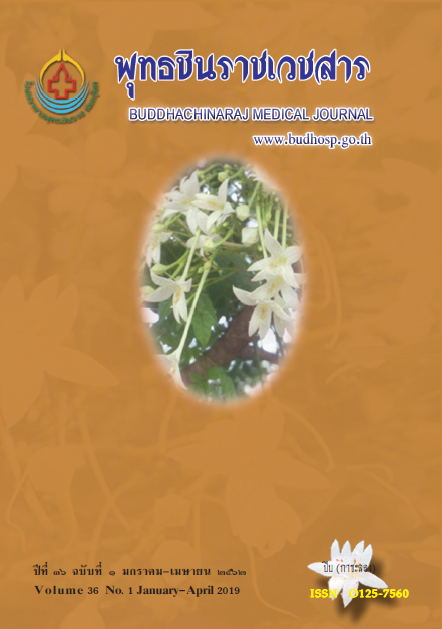คุณภาพชีวิตของผู้สูงอายุในศูนย์การเรียนรู้การดูแลผู้สูงอายุ เขตสุขภาพที่ 4
คำสำคัญ:
คุณภาพชีวิตผู้สูงอายุ, ศูนย์การเรียนรู้การดูแลผู้สูงอายุ, การมีส่วนร่วมในกิจกรรมส่งเสริมสุขภาพ, พฤติกรรมการบริโภคอาหาร, การออกกำลังกาย และอารมณ์บทคัดย่อ
ประเทศไทยมีเป้าหมายให้ประชาชนมีอายุยืนยาวและมีคุณภาพชีวิตที่ดีการวิจัยเป็นการศึกษากึ่งทดลอง มีวัตถุประสงค์เพื่อประเมินคุณภาพชีวิตเปรียบเทียบคุณลักษณะส่วนบุคคล พฤติกรรมสุขภาพการบริโภคอาหาร การออกกำลังกาย อารมณ์และคุณภาพชีวิตผู้สูงอายุ ของประชากรที่มีอายุ 60 ปี ขึ้นไป ก่อนและหลังเป็นสมาชิก ในศูนย์การเรียนรู้การดูแลผู้สูงอายุ เขตสุขภาพที่ 4ทั้งหมด 24 ชุมชนจำนวน 5,926 คน เก็บรวบรวมข้อมูลโดยการ สุ่มแบบระบบ ระหว่างเดือนกุมภาพันธ์ 2560- เดือนพฤษภาคม 2561 ให้ผู้สูงอายุตอบแบบสอบถามเครื่องมือที่ใช้ เป็นแบบสอบถามและแบบประเมินคุณภาพชีวิตผู้สูงอายุขององค์การอนามัยโลกชุดย่อฉบับภาษาไทย WHOQOLBREF- THAI วิเคราะห์ข้อมูลโดยใช้สถิติเชิงพรรณาประกอบด้วย ความถี่ ร้อยละ ค่าเฉลี่ย มัธยฐาน ส่วนเบี่ยงเบน มาตรฐานและสถิติเชิงอนุมาน ในการวิเคราะห์เปรียบเทียบโดยใช้ t-testที่ระดับนัยสำคัญ 0.05 ผลการศึกษา พฤติกรรมสุขภาพของผู้สูงอายุพบค่าเฉลี่ยและส่วนเบี่ยงเบนมาตรฐานของคะแนนรวมพฤติกรรมสุขภาพก่อนเข้า ร่วมโครงการ 69.69 (11.87) และหลังเข้าร่วมโครงการ 73.12(9.81)ผู้สูงอายุมีพฤติกรรมการออกกำลังกายและ การเข้าร่วมกิจกรรมส่งเสริมสุขภาพดีขึ้นคุณภาพชีวิตโดยรวมอยู่ในระดับปานกลาง ระดับดีและระดับไม่ดี เมื่อพิจารณารายมิติผู้สูงอายุมีคุณภาพชีวิตด้านจิตใจดีที่สุด รองลงมาคือด้านสิ่งแวดล้อม ด้านสุขภาพกายและ ด้านสัมพันธภาพทางสังคมตามลำดับ การพัฒนาศักยภาพชุมชนและผู้สูงอายุให้มีคุณภาพชีวิตที่ดีควรสร้าง กระบวนการมีส่วนร่วมของกิจกรรม เพิ่มกิจกรรมส่งเสริมสุขภาพให้ผู้สูงอายุเข้าถึงได้
เอกสารอ้างอิง
2. United Nations New York. Department of Economic and Social Affairs World Population Ageing 2017 Highlights. United Nations, 2017 All rights reserved. (Online). [cited 2018 May 17]. Available from: http://www.un.org/en/development/desa/population/theme/ageing/WPA2017.shtml
3. Office of the Permanent Secretary for Social Development and Human Security. Information and Communication Technology Center. ASEAN elderly population.Social Statistical Processing Document. Bangkok;2016.
4. National Statistical Office, Ministry of Information and Communication Technology. Report of the 2014 Population Survey in Thailand, Bangkok; 2014.
5. Institute for Population and Social Research. Population Substances, Mahidol University. Population of Thailand 2016, estimated population at the middle of 2016 (1 July). Year 25 January 2016. Nakhon Pathom. (Online). [Accessed on 17 July 2016]. Accessible from: URL: http://www.ipsr.mahidol.ac.th
6. Department of Health, Health Center 4, Saraburi. Inspection report, Round 2, 2017. Saraburi; 2560. [กรมอนามัย,ศูนย์อนามัยที่ 4 สระบุรี. รายงานการตรวจราชการรอบ 2 พ.ศ. 2560. สระบุรี;2560.]
7. Elderly Work Development Foundation. Situation of Thai elderly (health). Foundation of the Thai Elderly Research and Development Institute (PSU). Thai elderly situation 2014. Bangkok; 2015.
8. Ministry of Social Development and Human Security, National Elderly Committee. National Elderly Plan No. 2 (2002 - 2564). Revised Edition 1.Bangkok:Thepphen VanishPrinting, 2000.
9. Bureau of Policy and Strategy, Ministry of Public Health. Strategy, indicators and guidelines for data collection, Ministry of Public Health, fiscal year 2016. Bangkok;2016.
10. Saad focuses on the concepts and theories of health promotion and illness prevention;2013. [Accessed on 17 March 2017]. Accessible from: URL: http: //www.bcnsp.ac.th/2011/admin/att/05-07-2013 aorsaard_course.doc. [สอาด มุ่งสิน.แนวคิดและทฤษฎีการสร้างเสริมสุขภาพและการป้องกันการเจ็บป่วย;2556. [เข้าถึงเมื่อ17 มีนาคม2560].เข้าถึงได้จาก:URL:http://www.bcnsp.ac.th/2011/admin/att/05-07-2013 aorsaard_course.doc.]
11. Health Center 4, Saraburi, Elderly Health Promotion Group. Department of Public Health. Handbook for Elderly Prototyping, Elderly Care. Sustainable Elderly Care Learning Center Project on Health Behavior, Food Consumption and Exercise by Health Region 4. Nakhon Ratchasima:Community at Indy Design, 2017.
12. Boonsuya C. Population and sample selection. Compile a set of statistics and research methods in public health Sukhothai Thammathirat Open University.Nonthaburi:Sukhothai Thammathirat Open University;2001.
13. Phatana P. Quality of life for the elderly attending school for the elderly Saraburi Province. Independent research, Public Health, Thammasat University; 2560.[พัชราภรณ์ พัฒนะ. คุณภาพชีวิตผู้สูงอายุที่ เข้าโรงเรียน ผู้สูงอายุ จังหวัดสระบุรี. การค้นคว้าอิสระ, สาธารณสุขศาสตร์, มหาวิทยาลัยธรรมศาสตร์; 2560.]
14. Bureau of Nutrition. Department of Health, Ministry of Public Health. Guidelines for implementing hospitals to promote food health and nutrition towards sustainability, 2013.
15. Department of Mental Health. Mental health screening form: quality of life indicators of the World Health Organization, Thai version of the abbreviation. Program for mental health survey in the year 2002. Chiang Mai, 2002.
16. National Statistical Office. Ministry of Information and Communication Technology. Report of the 2014 Population Survey in Thailand, Bangkok, 2014.
17. Khamwong W, Nuasawat C, Prathanworapanya W, Panya C. Factors related to quality of life of the elderly. J Health Sci Res2011;5(2);32-40.
18. Elderly Work Development Foundation. Situation of Thai elderly (health). Foundation of the Thai Elderly Research and Development Institute (PSU). The situation of the Thai elderly in 2014. Bangkok; 2015.
19. Taengchuang Y. Guidelines for improving the quality of life for the elderly in Laplae District Phetchabun Province. Phetchabun Rajabhat J 2015;16(2):84-92.






